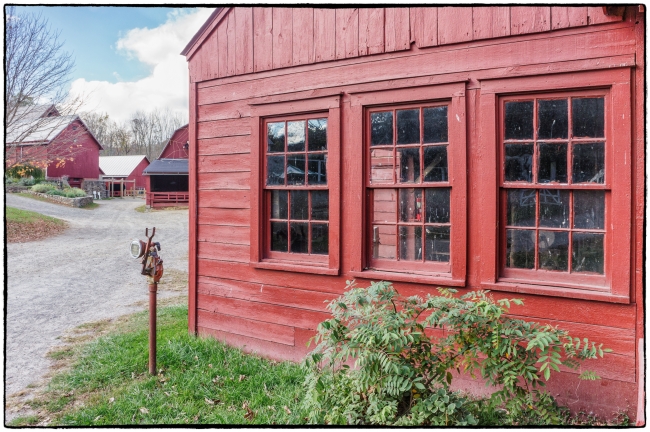Taken at Muscoot Farm in October, 2013. According to Wikipedia the farm has a long history:
The land on which Muscoot Farm is situated was part of the 86,000 acres (350 km2) Van Cortlandt Manor chartered in 1697. After the death of Stephanus Van Cortlandt in 1700 and his wife Gertrude in 1734, the manor was surveyed and divided into twenty large lots and twenty small lots. The Muscoot lands are located in “Great South Lot #6” which was inherited by Stephen Van Cortlandt. At that time, this region was very remote, inaccessible by roads, and probably uninhabited.
In 1802, the Great South Lot No. 6 was resurveyed by Ebenezer Purdy, Jr. and was subdivided into smaller lots proposed as tenant farms. Most of today’s Muscoot Farm lies within the Purdy’s lot number 3 and 5. The boundary separating lot 5 to the north and lot 3 on the south is still evident as the long straight stone wall that runs east and west across the park just north of the gazebo.
The part of Muscoot Farm that lies north of the stone wall (lot 5) was sold by Stephen Van Cortlandt in 1803 to Absalom Nelson, and it remained in the Nelson family for over 100 years.
The part of Muscoot Farm south of the stone wall (lot 3) was being leased by Joseph Montross at the time of the 1802 survey. A road ran through the property roughly coinciding with today’s Rt. 100, and Montross had a house on the west side of the road apparently near the site of the present Muscoot farmhouse. By the mid-19th century, after several land transactions, the Montross farm ended up in the hands of Ezra VanTassel at 157 acres (0.64 km2) in size. Peter Carpenter owned a 100-acre (0.40 km2) farm to the north; William Vail owned a 140-acre (0.57 km2) farm across the road to the east; and Lewis Ferris owned a small farm, about 30 acres (120,000 m2), to the south.
During the 1870s, at a time when farmland in Westchester was being sold off fairly cheaply, the three main farms (VanTassel, Carpenter and Vail) were purchased by Benjamin Brandeth, a pharmaceutical magnate from Ossining who had been dabbling in real estate ventures. During 1880’s this land was bought up by Ferdinand T. Hopkins another pharmaceutical executive from New York City.
Hopkins took these subsistence farms and developed them into a “Gentleman’s Farm”, a term applied to hobby farms owned by wealthy businessman who wished to maintain a connection with nature or with the farm life of their youth. Since profit was not the motive, Muscoot Farm, like most gentleman farms of that era, operated at a loss. It remained in the Hopkins family for almost 90 years and was finally sold to Westchester County in 1968.
It’s been a favorite spot for us to take visiting grandchildren over the years. When they’re young they like all the farm animals.
I like the bright reds of the barns and the sense of depth that comes from the larger building in the foreground and the smaller ones receding into the background.

